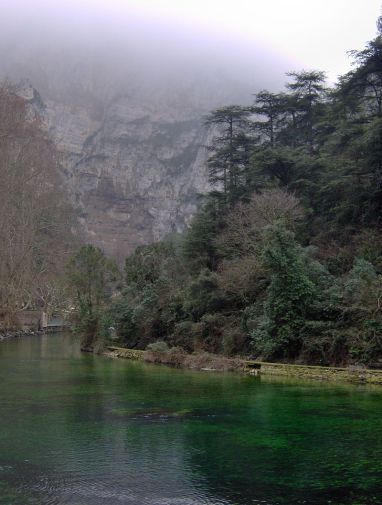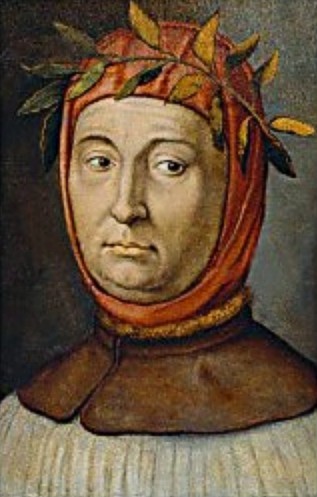Real-Life Twin Peaks Is A Town In France: A Halloween Post
 Bear with me, Dear Reader.
Bear with me, Dear Reader.
At the risk of arousing the ire of other Twin Peaks fans, I will add my own far-fetched fan theory as this year’s Halloween post. For what it’s worth, some of these thoughts have swirled in my mind since the first season of Twin Peaks (so, for decades), even before I knew of the existence of the French town I mention in the title. In the spirit holiday, please be patient and indulge me.
There is a small town in southern France called Fontaine-de-Vaucluse, named after a spring near which this tiny settlement was founded in the mists of deep antiquity, the source of the river Sorgue. It is located in a rugged mountainous region about forty kilometers east of Avignon. “Vaucluse” is a corruption of Latin Vallis Clausa, or “closed valley”. As you drive into this town — should you wish to visit such an out-of-the-way place — the “closed valley” becomes more and more like a deep canyon, the road and the burbling Sorgue bounded by vertical cliffs, into which nature carved numerous caves, and man actual dwellings. At the end of the road, there is a cul-de-sac in which the town sits, cradled by brooding mountains.
Tourists largely bypass Fontaine-de-Vaucluse. There is not much here of interest to people who get around by huge bus — no Roman amphitheater, no massive fortress, no baronial chateau. There is only an obligatory medieval church, a row of waterside cafes, some pastel-colored houses and a ruined castle looming over the town. It’s not a remarkable-looking town, nor a bustling one. Just a sleepy, picturesque French town at the end of a road, its beauty rendered somber by the severe mountains around it.

There are only two things that earn Fontaine-de-Vaucluse a passing mention in some guidebooks: an occasional fishing derby, and a small museum on the site of a since-vanished house that was once occupied by the immensely celebrated 14th-century Italian poet Petrarch.

From the time when I started watching Twin Peaks as a teenager, I played with the idea that the show is Lynch’s homage to Petrarch. It’s in the name of its first young murder victim, the girl who is always dead, yet exerts an immense gravitational force on the living, particularly the protagonist. Laura Palmer — what an evocative name it is! A name that, I’m sure, Lynch didn’t pick by accident. Believe me, Reader, no serious auteur names a dead woman “Laura” unless he’s trying to say something. That’s doubly so if he also names her Palmer.
Petrarch dedicated some of his most poignant poetry to a Laura, a girl he once saw in a church in Avignon and fell in love with. According to tradition, that woman was Laura de Noves. We know almost nothing about her aside from the useless (in this case, at any rate) factoid that she was a distant ancestress of Marquis de Sade. She was of gentle birth, she married young, she was virtuous, she had a passel of kids, she died of plague at thirty-eight — that’s pretty much all we know of her. No contemporaneous portrait of her is known to exist. According to Petrarch, she was blond.

Petrarch likely interacted very little with Laura de Noves, if at all. Medieval upper-class love — obligatorily, for another man’s wife — was by design solitary, contemplative, inward-looking; and usually chaste. Nevertheless, so devastated was he by her passing in 1348, he bought an estate not far from her hometown, in what is today Fontaine-de-Vaucluse, in order to be close to her resting place. He lived there for the next fifteen years.

Petrarch’s sketch of Vaucluse, later renamed Fontaine-de-Vaucluse
All this — Laura’s death, Petrarch’s seclusion in a remote town in the Vaucluse Mountains — took place amid the boundless devastation of the Black Death, Europe’s first, and deadliest, epidemic of the bubonic plague. It swept through southwestern Europe like a demonic force, wiping out at least a third, and perhaps as much as half, of the population. People died of the disease itself, leaving no one to farm, and with fields untilled, and crops rotting, still more people died of hunger. To those still clinging to life in that age — of faith, of superstition, of omens and religious heterodoxy — this invisible killer of multitudes, the open mass graves overflowing with corpses, the towns suddenly grown eerily quiet save for the cries of starving cattle, the forests teeming with feral hogs, felt like the end of civilization and the advent of the Apocalypse.

Against this backdrop of expiring humanity, Petrarch composed poetry of immense longing and expressiveness, dedicated to Laura. She did not exist as a real person. Rather, she was an idea, a muse, an obsession, an anchor in a world gone dark and mad, exhausted by the immense evil force bearing down upon it.

This notion did not escape even Petrarch’s contemporaries, nor the subsequent generations of readers. I mentioned that Laura de Noves is the Laura of Petrarch’s poetry according to tradition. I included that qualifier because there has always been some doubt whether Petrarch’s Laura was a real woman of flesh and blood at any point, or whether she was only an anthropomorphization of glory, of the laurels of Classical Antiquity that Petrarch attained with his art, his poetic alter ego.

Notice the parallels between Petrarch in this story and Dale Cooper in Lynch’s. Cooper is not a poet, but he is a survivor in a world full of unexplainable evil that cannot be grasped by the human mind. He’s never known Laura Palmer as a real person. She is not a real character, but his obsession, his muse if you will, whose shattered innocence so consume him that she, in death, comes to define his life. His obsession with her does not end with solving her murder. He lingers in Twin Peaks, and for much of the show, including the third season, his pursuit of justice for Laura Palmer (if not Laura Palmer herself) is an intensely introspective exercise.
“Laura” is for laurels, and “Palmer” — an old Crusader name — is for palms. One is a symbol of earthly glory, borne out of pagan Classical antiquity; the other a sacred religious symbol of eternal life. In the name of Laura Palmer, the two are intertwined. And wouldn’t you know it, Petrarch also put laurels and palms together in his Il Canzoniere:
Now pity brings me not the palm, or laurel,
but the peaceful olive and clear weather,
dries my tears, and wishes me still to live.
(230)
When my gentle comforter
to grant some peace to my weary life
settles herself on the left edge of my bed
with her sweet wise reasoning,
I grow pale at her pity and my fear,
saying: “O happy soul! where have you come from?”
She takes a little branch of palm
and one of laurel from her lovely breast
and says, “From the serene
heavenly empyrean and those sacred places
I moved, and came alone, to bring solace.”
(359)
the palm is victory, and I, still young
conquered myself and the world: the laurel
signifies triumph, of which I am worthy,
by grace of that lord who gave me strength
(359 again)
Laura Palmer is a quest born of a memory, much of it fantasized, an internal quest both glorious and sacred, for a man to find his meaning.
______________________________________________________________________________
You can find many pictures of Fontaine-de-Vaucluse, but pictures don’t convey what can only be experienced. The curved mountain hugging this town casts shadows and makes the afternoon light soft and strange. The caves, of an evening, look out onto the bridge, the little square, and the cafes like enormous all-seeing black eyes. The mountains give this town eerie echoes and barely perceptible sounds in the quiet air, like spirits rustling by.

In the winter, when the waters are low, the spring just outside the town falls and bares its source — a dark and ominous cave. According to legend, it was once the home of a demonic serpentine spirit called Coulobre.

Luckily, she was chased away by Saint Veranus, a native of Vaucluse and a bishop of Cavaillon (died c. 590).
Happy Halloween.

Not only are you a superb legal analyst and political demystifier nonpareil, but also a tremendous literary critic. An excellent article! In honor of Petrarch and Halloween, I will find some of his poetry online and read it today in between passing out sugar bombs to the costumed urchins parading in their scary attire. (I wonder if there are any anecdotes of Lynch visiting Fontaine-de-Vaucluse?)
Thanks! I am so glad you enjoyed it. Happy Halloween!